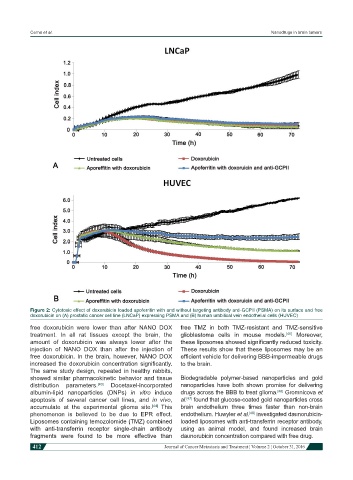Page 422 - Read Online
P. 422
Cerna et al. Nanodrugs in brain tumors
Figure 2: Cytotoxic effect of doxorubicin loaded apoferritin with and without targeting antibody anti-GCPII (PSMA) on its surface and free
doxorubicin on (A) prostatic cancer cell line (LNCaP) expressing PSMA and (B) human umbilical vein endothelial cells (HUVEC)
free doxorubicin were lower than after NANO DOX free TMZ in both TMZ-resistant and TMZ-sensitive
treatment. In all rat tissues except the brain, the glioblastoma cells in mouse models. Moreover,
[45]
amount of doxorubicin was always lower after the these liposomes showed significantly reduced toxicity.
injection of NANO DOX than after the injection of These results show that these liposomes may be an
free doxorubicin. In the brain, however, NANO DOX efficient vehicle for delivering BBB-impermeable drugs
increased the doxorubicin concentration significantly. to the brain.
The same study design, repeated in healthy rabbits,
showed similar pharmacokinetic behavior and tissue Biodegradable polymer-based nanoparticles and gold
distribution parameters. Docetaxel-incorporated nanoparticles have both shown promise for delivering
[43]
albumin-lipid nanoparticles (DNPs) in vitro induce drugs across the BBB to treat glioma. Gromnicova et
[46]
apoptosis of several cancer cell lines, and in vivo, al. found that glucose-coated gold nanoparticles cross
[47]
accumulate at the experimental glioma site. This brain endothelium three times faster than non-brain
[44]
phenomenon is believed to be due to EPR effect. endothelium. Huwyler et al. investigated daunorubicin-
[48]
Liposomes containing temozolomide (TMZ) combined loaded liposomes with anti-transferrin receptor antibody,
with anti-transferrin receptor single-chain antibody using an animal model, and found increased brain
fragments were found to be more effective than daunorubicin concentration compared with free drug.
412 Journal of Cancer Metastasis and Treatment ¦ Volume 2 ¦ October 31, 2016

